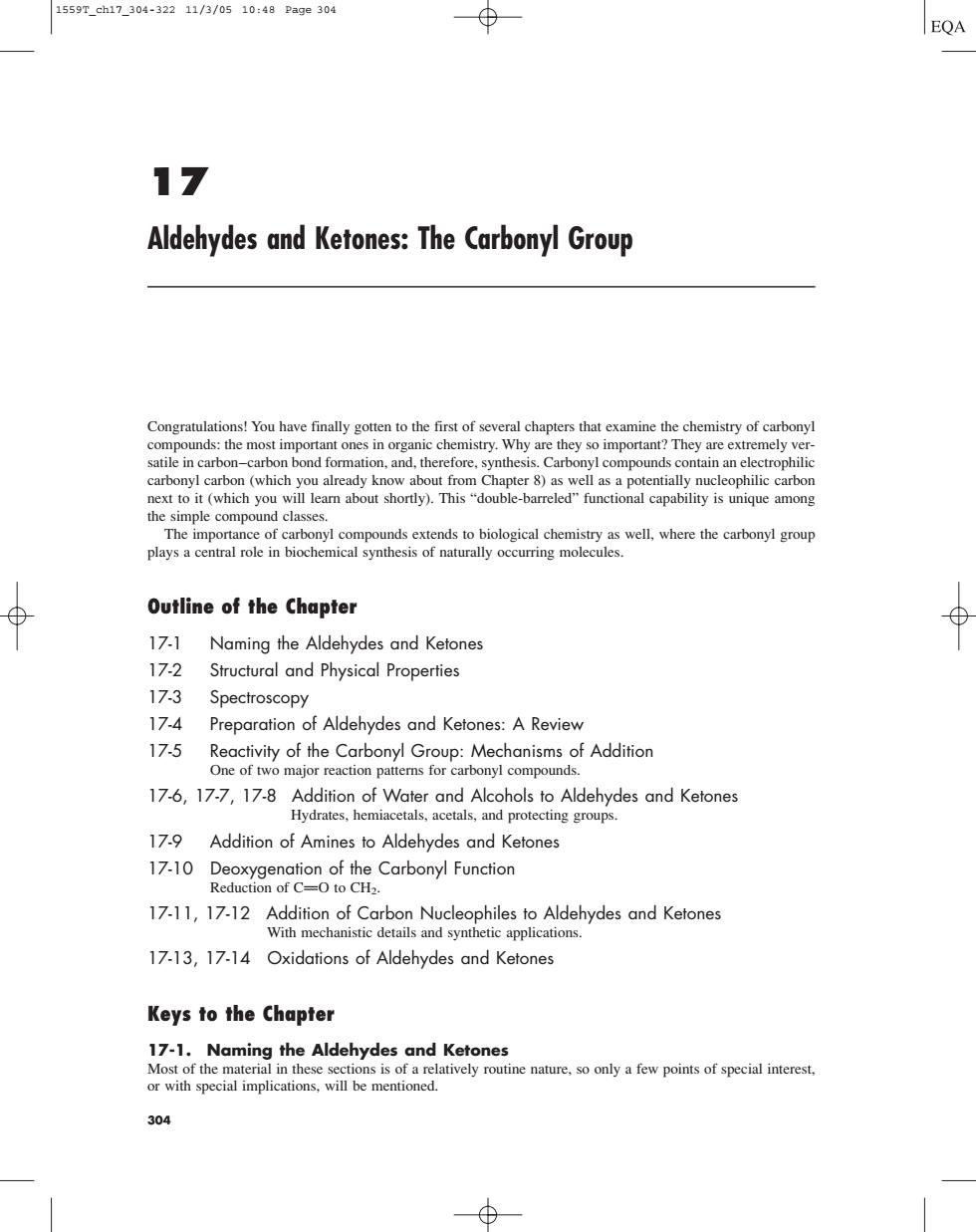正在加载图片...

1559T_ch17_304-32211/3/0510:48Pa9e304 EQA 17 Aldehydes and Ketones:The Carbonyl Group chapters that examine the chemistry of carbony satile in carboncarbon bond formation.and.therefore.synthesis.Carbonyl compounds contain an electrophilic carbonyl carbon (which the simpl compound cs The importance of carbonyl compounds extends to biological chemistry as well,where the carbonyl group plays a central role in biochemical synthesis of naturally occurring molecules Outline of the Chapter 17.1 Naming the Aldehydes and Ketones 17-2 Structural and Physical Properties 17-3 Spectroscopy 17.4 Preparation of Aldehydes and Ketones:A Review 17.5 o ma 17-6,17-7,17-8 Addition of Water and Alcohols to Aldehydes and Ketones Hydrates,hemiacetals,acetals,and protecting groups. 17-9 Addition of Amines to Aldehydes and Ketones 17-10 Deoxygenation of the Carbonyl Function Reduction of C=O to CH2. 17-11,17-12 Addition of Carbon Nucleophiles to Aldehydes and Ketones With mechanistic details and synthetic applications. 17-13,17-14 Oxidations of Aldehydes and Ketones Keys to the Chapter ons is of a relatively routine nature,so only a few points of special interest. or with special implications,will be mentioned 304 17 Aldehydes and Ketones: The Carbonyl Group Congratulations! You have finally gotten to the first of several chapters that examine the chemistry of carbonyl compounds: the most important ones in organic chemistry. Why are they so important? They are extremely versatile in carbon–carbon bond formation, and, therefore, synthesis. Carbonyl compounds contain an electrophilic carbonyl carbon (which you already know about from Chapter 8) as well as a potentially nucleophilic carbon next to it (which you will learn about shortly). This “double-barreled” functional capability is unique among the simple compound classes. The importance of carbonyl compounds extends to biological chemistry as well, where the carbonyl group plays a central role in biochemical synthesis of naturally occurring molecules. Outline of the Chapter 17-1 Naming the Aldehydes and Ketones 17-2 Structural and Physical Properties 17-3 Spectroscopy 17-4 Preparation of Aldehydes and Ketones: A Review 17-5 Reactivity of the Carbonyl Group: Mechanisms of Addition One of two major reaction patterns for carbonyl compounds. 17-6, 17-7, 17-8 Addition of Water and Alcohols to Aldehydes and Ketones Hydrates, hemiacetals, acetals, and protecting groups. 17-9 Addition of Amines to Aldehydes and Ketones 17-10 Deoxygenation of the Carbonyl Function Reduction of CPO to CH2. 17-11, 17-12 Addition of Carbon Nucleophiles to Aldehydes and Ketones With mechanistic details and synthetic applications. 17-13, 17-14 Oxidations of Aldehydes and Ketones Keys to the Chapter 17-1. Naming the Aldehydes and Ketones Most of the material in these sections is of a relatively routine nature, so only a few points of special interest, or with special implications, will be mentioned. 304 1559T_ch17_304-322 11/3/05 10:48 Page 304